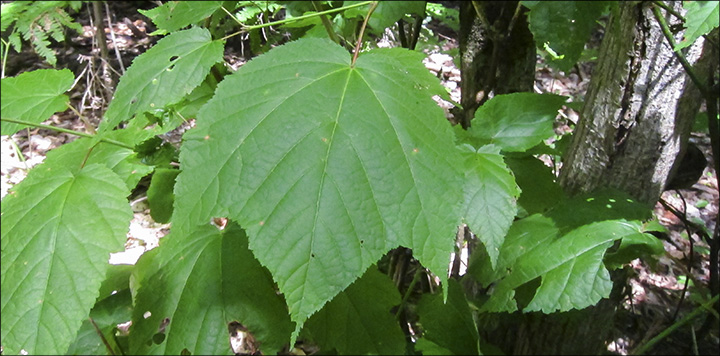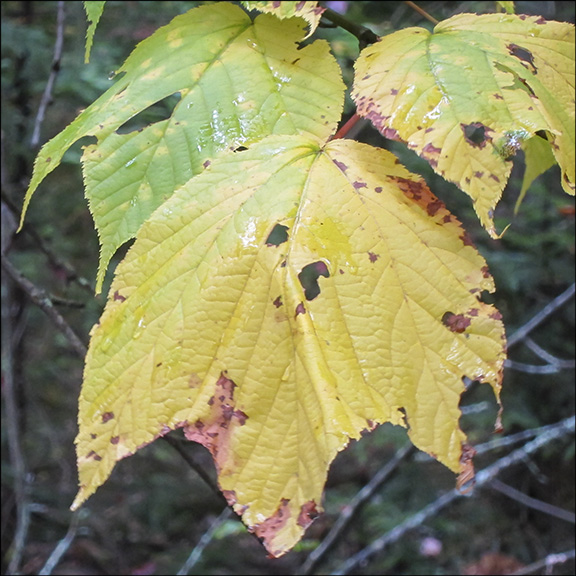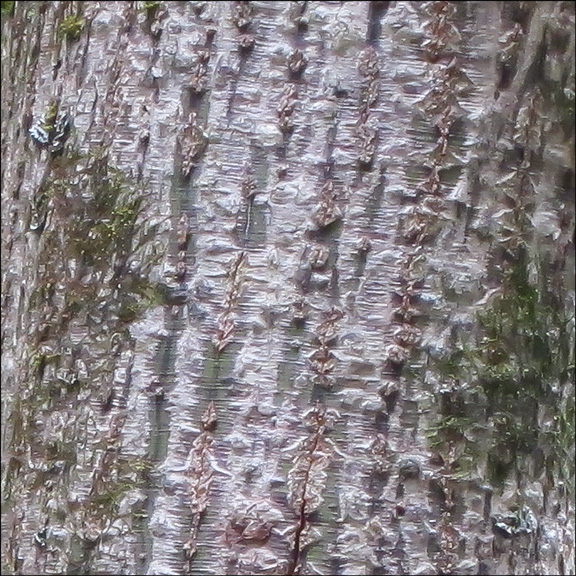Trees of the Adirondacks:
Striped Maple (Acer pensylvanicum)
 Trees of the Adirondacks: The leaves of the Striped Maple generally have three lobes. Striped Maple on the Barnum Brook Trail (21 July 2012)
Trees of the Adirondacks: The leaves of the Striped Maple generally have three lobes. Striped Maple on the Barnum Brook Trail (21 July 2012)
| This page is no longer being updated. For an updated and expanded version of this material, see: Striped Maple (Acer pensylvanicum). |
The Striped Maple (Acer pensylvanicum) is a small, deciduous understory tree or large shrub which flourishes in cool, moist woods in the Adirondack Mountains. Striped Maples are also known as Goosefoot or Goosefoot Maple – a reference to the fact that the leaf is shaped roughly like the foot of a goose. Striped Maple are also known as Moosewood – a reference to the fact that the bark is consumed by moose in winter. The plant is also referred to as Pennsylvania Maple (a reference to the state of Pennsylvania, where the tree is a native species) and Snakebark Maple (a reference to its distinctive striped bark). Striped Maple trees grow up to about 30 feet high.

Identification of the Striped Maple: Like other maples, Striped Maples have opposite, lobed leaves. The leaves of the Striped Maple are large, thin, and somewhat papery. They usually have three triangular, forward-pointing lobes, with a large central lobe. The margins of the leaves are finely toothed. The base of the leaf is rounded or slightly heart-shaped. Striped Maple leaves are a deep yellow-green and smooth above, turning yellow in autumn. The bark is green with thin stripes, becoming gray as the tree ages. The twigs are green and hairless, becoming striped with whitish lines.
Keys to identifying the Striped Maple and differentiating it from other maples include its leaves, bark, and growth habit.
- Although Red Maple, Striped Maple, and Mountain Maple all have toothed leaf margins, the shape of Red Maple leaves is different from those of the Striped Maple and Mountain Maple. Red Maple leaves are more deeply lobed than those of the Striped Maple and Mountain Maple.
- The leaves of the Striped Maple differ from those of the Sugar Maple, which has several pointed tips on each lobe. By contrast, Striped Maple leaves are uniformly and finely double-toothed.
- Mountain Maple leaves resemble those of the Striped Maple. Both generally have three lobes with a heart-shaped or rounded base, although the Mountain Maple leaf sometimes has five lobes. However, Mountain Maple leaves are coarsely-toothed, contrasting with the tiny teeth of the Striped Maple leaf. Mountain Maple leaves are also somewhat smaller on average.
- The striped bark of the Striped Maple contrasts with that of the Mountain Maple, which is darker and reddish brown, without conspicuous vertical striping.
- The growth habit of the Striped Maple contrasts with that of both the Sugar Maple and the Red Maple. Both of these latter species mature into large trees, with a straight, single trunk, while the Striped Maple is a small tree or large shrub, often divided into several branches from near the base.

The Striped Maple flowers in late spring or early summer, following leaf development. The flowers are small and greenish yellow, arranged in loose drooping clusters. The fruits are somewhat reddish in early development, changing later to tan. The fruits have widely spaced wings and are about 3/4 inch long, maturing in late summer and early fall.
Uses of the Striped Maple: The Striped Maple has limited uses. Its porous and fine grained wood has occasionally been used by cabinet makers for inlay material. Native American tribes reportedly used the wood to make arrows and the bark to make a beverage. Farmers in the American colonies and Canada reportedly fed their cattle both dried and green leaves in the winter; in the spring, when the buds had begun to swell, they turned their horses and cows into the woods to browse on the young shoots. Native American tribes used the the Striped Maple to treat a variety of ailments including bronchial and kidney troubles, colds, and coughs.
Wildlife Value of the Striped Maple: The Striped Maple is probably most important as a browse plant for wildlife. Its twigs are browsed by snowshoe hare; red squirrels and chipmunks eat the seeds. Striped Maple is frequently eaten by porcupines. The Striped Maple also provides browse for white-tailed deer and moose, though the net energy derived from winter browse is relatively low. Ruffed grouse consume the vegetative buds. Striped maple are also very useful to wildlife in that these small understory trees help diversify the vertical profile of a forest, creating the dense layers in a woodland that are attractive to many wildlife species for nesting, feeding, and perching.

Distribution of the Striped Maple: This tree is widely distributed over the northeastern quarter of the United States and southeastern Canada, including most of the counties of New York State. The natural range of the Striped Maple extends from Nova Scotia west to southern Ontario, Michigan, and eastern Minnesota. The Striped Maple grows south to northeastern Ohio, Pennsylvania and New Jersey. It also grows in the mountains to northern Georgia.
Striped Maple is an indicator species for the Northern Hardwood Forest. These trees are also common in mixed hardwood-conifer forests. The canopy in the Northern Hardwood Forest is dominated by Sugar Maple, Yellow Birch, Eastern Hemlock, American Beech, and Eastern White Pine, while Striped Maple trees, together with Hobblebush, are common in the understory layer. Herbaceous species which thrive here include Painted Trillium, Goldthread, Common Wood Sorrel, Carolina Spring Beauty, Pink Lady's Slipper, and Wild Sarsaparilla. Birds commonly seen and heard in the Northern Hardwood Forest and mixed hardwood-conifer forest include the White-throated Sparrow, Dark-eyed Junco, Purple Finch, Mourning Warbler, American Redstart, Black-throated Blue Warbler, Hermit Thrush, Black-capped Chickadee, Brown Creeper, Golden-crowned Kinglet, Yellow-bellied Sapsucker, and Cedar Waxwing.
Striped Maples at the Paul Smiths VIC: In contrast to Black Spruce and Tamarack, the Striped Maple does not grow in the VIC's wetland areas, such as Heron Marsh and Barnum Bog. Moreover, in contrast to the Red Maple, the Striped Maple is not tolerant of wetter soil and so are not found along the marsh or boggy edges. Look for Striped Maple in our drier and better-drained upland soils. This species may be seen along the southwest side of the Heron Marsh Trail between the floating bridge and the long boardwalk. The most convenient place to observe Striped Maple trees is on the Barnum Brook Trail. The Striped Maple is one of the eleven tree species marked with signage along this trail, providing a convenient way to learn to differentiate this species from Red Maples and Sugar Maples, which are also identified on the trail.
References
- United States Department of Agriculture. Forest Service. Silvics of North America. Striped Maple. Retrieved 23 January 2015.
- United States Department of Agriculture. Plants Database. Retrieved 23 January 2015.
- Lady Bird Johnson Wildflower Center. Native Plant Database. Retrieved 23 January 2015.
- University of Wisconsin. Trees of Wisconsin. Acer pensylvanicum. Retrieved 23 January 2015.
- Online Encyclopedia of Life. Acer pensylvanicum. Retrieved 23 January 2015.
- University of Wisconsin. Robert W. Freckmann Herbarium. Retrieved 23 January 2015.
- New York Flora Association. New York Flora Atlas. Retrieved 23 January 2015.
- University of Michigan. Native American Ethnobotany. A Database of Foods, Drugs, Dyes and Fibers of Native American Peoples, Derived from Plants. Retrieved 23 January 2015..
- Plants for a Future. Database. Retrieved 23 January 2015.
- The Birds of North America. Black-throated Blue Warbler. Subscription Web Site. Retrieved 23 January 2015.
- Trees of the Northern Forest Trail Walk
- Paul Smith’s College VIC. Barnum Brook Tree Game.
- Michael Wojtech. Bark: A Field Guide to Trees of the Northeast (UPNE, 2011).
- George A. Petrides. A Field Guide to Eastern Trees (Boston: Houghton Mifflin Company, 1998), pp. 54-55, 202-203.
- George A. Petrides. A Field Guide to Trees and Shrubs (Boston: Houghton Mifflin Company, 1958,1972), pp. 96-97, 120-121.
- John Kricher. A Field Guide to Eastern Forests. North America (Boston: Houghton Mifflin Company, 1998), pp. 72-75, 126-127, 437.
- Gil Nelson, Christopher J. Earle, and Richard Spellenberg. Trees of Eastern North America (Princeton : Princeton University Press), pp. 622-623.
- C. Frank Brockman. Trees of North America (New York: St. Martin's Press), pp. 214-215.
- Keith Rushforth and Charles Hollis. Field Guide to the Trees of North America (Washington, D.C., National Geographic, 2006), p. 204.
- National Audubon Society. Field Guide to North American Trees (New York: Alfred A. Knopf, 1980), Plates 255 and 623, pp. 574-575.
- Allen J. Coombes. Trees (New York: Dorling Kindersley, Inc., 1992), p. 96.
- William Carey Grimm. The Illustrated Book of Wildflowers and Shrubs (Mechanicsburg, PA, 1993), pp. 496-497.
